A Union of Dynamic Hydrological Modeling and Satellite Remotely-Sensed Data for Spatiotemporal Assessment of Sediment Yields
Abstract
:1. Introduction
2. Materials and Methods
2.1. Dynamic Models of C-Factor and K-Factor
2.1.1. C-Factor Model
2.1.2. K-Factor Model
2.2. SWAT Model
2.3. Development of Connective Algorithm
2.4. Validation of Connective Algorithm
2.4.1. Sensitivity Analysis
2.4.2. Performance Evaluation
2.5. Spatiotemporal Analysis
2.5.1. Spatial Interpolation and Mapping
2.5.2. Temporal Trend Detection
2.6. Case Study Areas
Data and Modeling
3. Results
3.1. SWAT Calibration and Validation Results
3.2. Results of Connective Algorithm Validation
3.3. Spatiotemporal Predictions of C-Factor and K-Factor
4. Discussions
4.1. Spatiotemporal Predictions of Sediment Yields
4.2. Study Limitations
5. Conclusions
Author Contributions
Funding
Data Availability Statement
Acknowledgments
Conflicts of Interest
References
- Lal, R. Soil degradation by erosion. Land Degrad. Dev. 2001, 12, 519–539. [Google Scholar] [CrossRef]
- Montanarella, L. Trends in Land Degradation in Europe; Springer: Berlin, Germany, 2007; pp. 83–104. Available online: http://www.wamis.org/agm/meetings/wocald06/S2-Montanarella.pdf (accessed on 25 January 2020).
- Young, C.J.; Liu, S.; Schumacher, J.A.; Schumacher, T.E.; Kaspar, T.C.; McCarty, G.W.; Napton, D.; Jaynes, D.B. Evaluation of a model framework to estimate soil and soil organic carbon redistribution by water and tillage using 137Cs in two US Midwest agricultural fields. Geoderma 2014, 232, 437–448. [Google Scholar] [CrossRef]
- Kinnell, P.I.A. Determining soil erodibilities for the USLEMM rainfall erosion model. Catena 2018, 163, 424–426. [Google Scholar] [CrossRef]
- Bernatek-Jakiel, A.; Poesen, J. Subsurface erosion by soil piping: Significance and research needs. Earth Sci. Rev. 2018, 185, 1107–1128. [Google Scholar] [CrossRef]
- Preetha, P.P.; Al-Hamdan, A.Z.; Anderson, M.D. Assessment of climate variability and short term land use land cover change effects on water quality of Cahaba river basin. Int. J. Hydrol. Sci. Technol. 2019, 11, 54–75. [Google Scholar] [CrossRef]
- Preetha, P.P.; Al-Hamdan, A.Z. Developing Nitrate-Nitrogen Transport Models using Remotely-Sensed Geospatial Data of Soil Moisture Profiles and Wet Depositions. J. Environ. Sci. Health Part A 2020, 55, 615–628. [Google Scholar] [CrossRef]
- Kwon, H.; Park, G.; Kim, S. Estimation of soil loss changes and sediment transport path using GIS and multi-temporal RS data. J. GIS Assoc. Korea 2002, 10, 134–147. [Google Scholar] [CrossRef] [Green Version]
- Cho, H.L.; Jeong, J.C. Estimating soil loss in alpine farmland with RUSLE and SEDD. J. GIS Assoc. Korea 2005, 13, 79–90. [Google Scholar]
- Lee, G.; Hwang, E. The influence analysis of GIS-based soil Erosion in water-pollutant buffering zone. J. Korean Soc. Civ. Eng. 2006, 26, 335–340. [Google Scholar]
- Wischmeier, W.H.; Smith, D.D. Predicting rainfall-erosion losses—A guide to conservation planning. In Agriculture Handbook 537; US Department of Agriculture: Washington, DC, USA, 1978. Available online: https://naldc.nal.usda.gov/download/CAT79706928/PDF (accessed on 17 January 2019).
- Renard, K.G.; Foster, G.R.; Weesies, G.A.; McCool, D.K. Predicting Soil Erosion by Water: A Guide to Conservation Planning with the Revised Universal Soil Loss Equation (RUSLE); Agricultural Handbook; US Department of Agriculture: Washington, DC, USA, 1997; Volume 703. Available online: https://www3.epa.gov/npdes/pubs/ruslech2.pdf (accessed on 17 January 2019).
- Renard, K.G.; Foster, G.R.; Weesies, G.A. RUSLE: Revised universal soil loss equation. J. Soil Water Conserv. 1991, 46, 30–33. [Google Scholar]
- Williams, J.R. Sediment routing for agricultural watersheds. JAWRA 1975, 11, 965–974. [Google Scholar] [CrossRef]
- Kinnell, P.I.A.; Risse, L.M. USLE-M: Empirical modeling rainfall erosion through runoff and sediment concentration. Soil Sci. Soc. Am. J. 1998, 62, 1667–1672. [Google Scholar] [CrossRef]
- Flacke, W.; Auerswald, K.; Neufang, L. Combining a modified Universal Soil Loss Equation with a digital terrain model for computing high resolution maps of soil loss resulting from rain wash. Catena 1990, 17, 383–397. [Google Scholar] [CrossRef]
- Van Oost, K.; Govers, G.; Desmet, P. Evaluating the effects of changes in landscape structure on soil erosion by water and tillage. Landsc. Ecol. 2000, 15, 577–589. [Google Scholar] [CrossRef]
- Van Rompaey, A.J.; Verstraeten, G.; Van Oost, K.; Govers, G.; Poesen, J. Modelling mean annual sediment yield using a distributed approach. Earth Surf. Process. Landf. 2001, 26, 1221–1236. [Google Scholar] [CrossRef]
- Haregeweyn, N.; Yohannes, F. Testing and evaluation of the agricultural non-point source pollution model (AGNPS) on Augucho catchment, western Hararghe, Ethiopia. Agric. Ecosyst. Environ. 2003, 99, 201–212. [Google Scholar] [CrossRef]
- Xian, G.; Crane, M. Assessments of urban growth in the TBW using remote sensing data. Remote Sens. Environ. 2005, 97, 203–215. [Google Scholar] [CrossRef]
- Moreno-Madrinan, M.J.; Al-Hamdan, M.Z.; Rickman, D.L.; Muller-Karger, F.E. Using the surface reflectance MODIS Terra product to estimate turbidity in Tampa Bay, Florida. Remote Sens. 2010, 2, 2713–2728. [Google Scholar] [CrossRef]
- Moreno-Madrinan, M.J.M.; Al-Hamdan, M.Z.; Rickman, D.L.; Ye, J. Relationship between watershed land cover/land-use change and water turbidity status of Tampa Bay major tributaries, Florida, USA. Water Air Soil Pollut. 2012, 223, 2093–2109. [Google Scholar] [CrossRef]
- Pandey, A.; Himanshu, S.K.; Mishra, S.; Singh, V.P. Physically based soil erosion and sediment yield models revisited. Catena 2016, 147, 595–620. [Google Scholar] [CrossRef]
- Prasannakumar, V.; Vijith, H.; Abinod, S.; Geetha, N. Estimation of soil erosion risk within a small mountainous sub-watershed in Kerala, India, using Revised Universal Soil Loss Equation (RUSLE) and geo-information technology. Geosci. Front. 2012, 3, 209–215. [Google Scholar] [CrossRef] [Green Version]
- Mancino, G.; Nole, A.; Ripullone, F.; Ferrara, A. Landsat TM imagery and NDVI differencing to detect vegetation change: Assessing natural forest expansion in Basilicata, southern Italy. iForest 2014, 7, 75–84. [Google Scholar] [CrossRef] [Green Version]
- Karaburun, A. Estimation of C-factor for soil erosion modeling using NDVI in Buyukcekmece watershed. OJAS Ozean J. Appl. Sci. 2010, 3, 77–85. [Google Scholar]
- Waldhoff, G.; Lussem, U.; Bareth, G. Multi-data approach for remote sensing-based regional crop rotation mapping: A case study for the Rur catchment, Germany. Int. J. Appl. Earth Obs. 2017, 61, 55–69. [Google Scholar] [CrossRef]
- De Jong, S.M.; Paracchini, M.L.; Bertolo, F.; Folving, S.; Megier, J.; De Roo, A.P.J. Regional assessment of soil erosion using the distributed model SEMMED and remotely-sensed data. Catena 1999, 37, 291–308. [Google Scholar] [CrossRef]
- Gertner, G.; Wang, G.; Fang, S.; Anderson, A.B. Mapping and uncertainty of predictions based on multiple primary variables from joint co-simulation with Landsat TM image and polynomial regression. Remote Sens. Environ. 2002, 83, 498–510. [Google Scholar] [CrossRef]
- Yuan, F. Land-cover change and environmental impact analysis in the Greater Mankato area of Minnesota using remote sensing and GIS modeling. Int. J. Remote Sens. 2008, 29, 1169–1184. [Google Scholar] [CrossRef]
- Godínez-Alvarez, H.; Herrick, J.E.; Mattocks, M.; Toledo, D.; Van Zee, J. Comparison of three vegetation monitoring methods: Their relative utility for ecological assessment and monitoring. Ecol. Indic. 2009, 9, 1001–1008. [Google Scholar] [CrossRef]
- Bieger, K.; Arnold, J.G.; Rathjens, H.; White, M.J.; Bosch, D.D.; Allen, P.M.; Srinivasan, R. Introduction to SWAT+, a completely restructured version of the soil and water assessment tool. JAWRA J. Am. Water Resour. Assoc. 2016, 53, 115–130. [Google Scholar] [CrossRef]
- Folly, A.; Bronsveld, M.C.; Clavaux, M. A knowledge-based approach for C-factor mapping in Spain using Landsat TM and GIS. Int. J. Remote Sens. 1996, 17, 2401–2415. [Google Scholar] [CrossRef]
- Wang, G.; Wente, S.; Gertner, G.Z.; Anderson, A. Improvement in mapping vegetation cover factor for the universal soil loss equation by geostatistical methods with Landsat Thematic Mapper images. Int. J. Remote Sens. 2002, 23, 3649–3667. [Google Scholar] [CrossRef]
- Matsushita, B.; Yang, W.; Chen, J.; Ond, Y.; Qiu, G. Sensitivity of the Enhanced Vegetation Index (EVI) and Normalized Difference Vegetation Index (NDVI) to topographic effects: A case study in high-density Cypress forest. Sensors 2007, 7, 2636–2651. [Google Scholar] [CrossRef] [PubMed] [Green Version]
- Panico, S.C.; Memoli, V.; Esposito, F.; Maisto, G.; De Marco, A. Plant cover and management practices as drivers of soil quality. Appl. Soil Ecol. 2018, 129, 34–42. [Google Scholar] [CrossRef]
- McDonald, S.E.; Reid, N.; Waters, C.M.; Smith, R.; Hunter, J. Improving ground cover and landscape function in a semi-arid rangeland through alternative grazing management. Agric. Ecosyst. Environ. 2018, 268, 8–14. [Google Scholar] [CrossRef]
- Foster, G.R. Draft: Science Documentation, Revised Universal Soil Loss Equation Version 2 (RUSLE2); USDA—Agricultural Research Service: Washington, DC, USA, 2005. [Google Scholar]
- Zhang, K.L.; Shu, A.P.; Xu, X.L.; Yang, Q.K.; Yu, B. Soil erodibility and its estimation for agricultural soils in China. J. Arid Environ. 2008, 72, 1002–1011. [Google Scholar] [CrossRef]
- Vaezi, A.R.; Sadeghi, S.H.; Bahrami, H.A.; Mahdian, M. Modeling the USLE K-factor for calcareous soils in northwestern Iran. Geomorphology 2008, 97, 414–423. [Google Scholar] [CrossRef]
- Mattheus, C.; Norton, M. Comparison of pond-sedimentation data with a GIS-based USLE model of sediment yield for a small forested urban watershed. Anthropocene 2013, 2, 89–101. [Google Scholar] [CrossRef]
- Shabani, F.; Kumar, L.; Esmaeili, A. Improvement to the prediction of the USLE K factor. Geomorphology 2014, 204, 229–234. [Google Scholar] [CrossRef]
- Ostovari, Y.; Ghorbani-Dashtaki, S.; Bahrami, H.; Naderi, M.; Dematte, J.; Kerry, R. Modification of the USLE k factor for soil erodibility assessment on calcareous soils in Iran. Geomorphology 2016, 273, 385–395. [Google Scholar] [CrossRef]
- Wang, B.; Zheng, F.; Guan, Y. Improved USLE-k factor prediction: A case study on water erosion areas in China. Int. Soil Water Conserv. Res. 2016, 4, 168–176. [Google Scholar] [CrossRef] [Green Version]
- Molina-Navarro, E.; Andersen, H.; Nielsen, A.; Thodsen, H.; Trolle, D. The impact of the objective function in multi-site and multi-variable calibration of the SWAT model. Environ. Model Softw. 2017, 93, 255–267. [Google Scholar] [CrossRef]
- Pham, T.G.; Degener, J.; Kappas, M. Integrated universal soil loss equation (USLE) and geographical information system (GIS) for soil erosion estimation in a sap basin; Central Vietnam. Int. Soil Water Conserv. Res. 2018, 6, 99–110. [Google Scholar] [CrossRef]
- Basic, F.; Kisic, I.; Mesic, M.; Nestroy, O.; Butorac, A. Tillage and crop management effects on soil erosion in central Croatia. Soil Tillage Res. 2004, 78, 197–206. [Google Scholar] [CrossRef]
- Ucar, Z.; Bettinger, P.; Merry, K.; Akbulut, R.; Siry, J. Estimation of urban woody vegetation cover using multispectral imagery and LiDAR. Urban For. Urban Green. 2018, 29, 248–260. [Google Scholar] [CrossRef]
- Deng, J.S.; Wang, K.; Deng, Y.H.; Qi, G.J. PCA-based land-use change detection and analysis using multitemporal and multisensor satellite data. Int. J. Remote Sens. 2008, 29, 4823–4838. [Google Scholar] [CrossRef]
- Wu, H.; Chen, B. Evaluating uncertainty estimates in distributed hydrological modeling for the Wenjing River watershed in China by GLUE, SUFI-2, and ParaSol methods. Ecol. Eng. 2015, 76, 110–121. [Google Scholar] [CrossRef]
- Abbaspour, K.C.; Johnson, C.A.; van Genuchten, M.T. Estimating uncertain flow and transport parameters using a sequential uncertainty fitting procedure. Vadose Zone J. 2004, 3, 1340–1352. [Google Scholar] [CrossRef]
- Abbaspour, K.C.; Rouholahnejad, E.; Vaghefi, S.; Srinivasan, R.; Yang, H.; Kløve, B. A continental-scale hydrology and water quality model for Europe: Calibration and uncertainty of a high-resolution large-scale SWAT model. J. Hydrol. 2015, 524, 733–752. [Google Scholar] [CrossRef] [Green Version]
- Wellen, C.; Arhonditsis, G.B.; Long, T.; Boyd, D. Quantifying the uncertainty of nonpoint source attribution in distributed water quality models: A Bayesian assessment of SWAT’s sediment export predictions. J. Hydrol. 2014, 519, 3353–3368. [Google Scholar] [CrossRef]
- Santhi, C.; Arnold, J.G.; Williams, J.R.; Dugas, W.A.; Srinivasan, R.; Hauck, L.M. Validation of the SWAT model on a large river basin with point and nonpoint sources. J. Am. Water Resour. Assoc. 2001, 37, 1169–1188. [Google Scholar] [CrossRef]
- Van Griensven, A.; Ndomba, P.; Yalew, S.; Kilonzo, F. Critical review of SWAT applications in the upper Nile basin countries. Hydrol. Earth Syst. Sci. 2012, 16, 3371–3381. [Google Scholar] [CrossRef] [Green Version]
- Zeiger, S.J.; Hubbart, J.A. A SWAT model validation of nested-scale contemporaneous stream flow, suspended sediment and nutrients from a multiple-land-use watershed of the central USA. Sci. Total Environ. 2016, 572, 232–243. [Google Scholar] [CrossRef] [PubMed]
- Arnold, J.; Bieger, K.; White, M.; Srinivasan, R.; Dunbar, J.; Allen, P. Use of Decision Tables to Simulate Management in SWAT+. Water 2018, 10, 713. [Google Scholar] [CrossRef] [Green Version]
- Li, R.; Li, J. Satellite remote sensing technology for lake water clarity monitoring: An overview. Environ. Inf. Arch. 2004, 2, 893–901. [Google Scholar]
- Schultz, G.A.; Engman, E.T. Remote Sensing in Hydrology and Water Management; Springer: Berlin/Heidelberg, Germany, 2000. [Google Scholar]
- Chen, Z.; Hu, C.; Muller-Karger, F. Monitoring turbidity in Tampa Bay using MODID/Aqua 250-m imagery. Remote Sens. Environ. 2007, 109, 207–220. [Google Scholar] [CrossRef]
- USGS LP DAAC. MODIS/Terra Surface Reflectance 8-Day L3 Global 500m SIN Grid V006. 2019. Available online: https://search.earthdata.nasa.gov/search/granules?p=C193529899-LPDAAC_ECS&tl=1534089058!4!!&q=modis%20surface&ok=modis%20surface (accessed on 23 January 2019).
- Hajigholizadeh, M. Water Quality Modelling Using Multivariate Statistical Analysis and Remote Sensing in South Florida. Ph.D. Thesis, Florida International University, Miami, FL, USA, 2016. [Google Scholar]
- Weng, Q. Land use change analysis in the Zhujiang delta of China using satellite remote sensing, GIS and stochastic modeling. J. Environ. Econ. Manag. 2002, 64, 273–284. [Google Scholar] [CrossRef] [Green Version]
- Wu, Q.; Li, H.; Wang, R.; Paulussen, J.; He, Y.; Wang, M.; Wang, B.; Wang, Z. Monitoring and predicting land use change in Beijing using remote sensing and GIS. Landsc. Urban Plan. 2006, 78, 322–333. [Google Scholar] [CrossRef]
- Onate-Valdivieso, F.; Sendra, J.B. Application of GIS and remote sensing techniques in generation of land use scenarios for hydrological modeling. J. Hydrol. 2010, 395, 256–263. [Google Scholar] [CrossRef]
- Li, L.; Meng, Q.Y. Reviews of phosphorus transport and transformation in soil under freezing and thawing actions. Front. Ecol. Environ. 2013, 6, 1074–1078. [Google Scholar]
- Asmamaw, L.B.; Mohammed, A.A. Effects of slope gradient and changes in land use/cover on selected soil physico-biochemical properties of the Gerado catchment, north-eastern Ethiopia. Int. J. Environ. Stud. 2013, 70, 111–125. [Google Scholar] [CrossRef]
- Mugagga, F.; Kakembo, V.; Buyinza, M. Land use changes on the slopes of Mount Elgon and the implications for the occurrence of landslides. Catena 2012, 90, 39–46. [Google Scholar] [CrossRef]
- USGS. LP DAAC. MODIS/Terra Leaf Area Index/FPAR 8-Day L4 Global 500m SIN Grid V006. 2019. Available online: https://search.earthdata.nasa.gov/search/granules?p=C203669720-LPDAAC_ECS&tl=1534089058!4!!&q=modis%20lai&ok=modis%20lai (accessed on 17 January 2019).
- USGS. LP DAAC. MODIS/Terra Vegetation Indices 16-Day L3 Global 250m SIN Grid V006. 2019. Available online: https://search.earthdata.nasa.gov/search/granules?p=C194001241-LPDAAC_ECS&tl=1534089058!4!!&q=modis%20evi&ok=modis%20evi (accessed on 25 January 2019).
- Preetha, P.P.; Al-Hamdan, A.Z. Synergy of remotely sensed data in spatiotemporal dynamic modeling of the crop and cover management factor. Pedosphere 2022, 32, 381–392. [Google Scholar] [CrossRef]
- Neitsch, S.L.; Arnold, J.G.; Kiniry, J.R.; Williams, J.R. Soil & Water Assessment Tool: Theoretical Documentation Version 2009; TR-406; Texas Water Resources Institute: Temple, TX, USA, 2011; Available online: https://swat.tamu.edu/media/99192/swat2009-theory.pdf (accessed on 24 January 2020).
- Preetha, P.P.; Al-Hamdan, A.Z. Multi-level pedotransfer modification functions of the USLE-K factor for annual soil erodibility estimation of mixed landscapes. Model. Earth Syst. Environ. 2019, 5, 767–779. [Google Scholar] [CrossRef]
- Arnold, J.G.; Srinivasan, R.; Muttiah, R.S.; Williams, J.R. Large area hydrologic modeling and assessment Part I: Model development. JAWRA J. Am. Water Resour. Assoc. 1998, 34, 73–89. [Google Scholar] [CrossRef]
- Neitsch, S.L.; Arnold, J.G.; Kiniry, J.R.; Williams, J.R. Soil and Water Assessment Tool Theoretical Documentation Version 2000: Draft-April 2001; Grassland, Soil and Water Research Laboratory: Temple, TX, USA, 2001. [Google Scholar]
- Risal, A. Application of Web ERosivity Module (WERM) for estimation of annual and monthly R factor in Korea. Catena 2016, 147, 225–237. [Google Scholar] [CrossRef]
- Sadeghi, S.H.; Zabihi, M.; Vafakhah, M.; Hazbavi, Z. Spatiotemporal mapping of rainfall erosivity index for different return periods in Iran. Nat. Hazards 2017, 87, 35–56. [Google Scholar] [CrossRef]
- Yue, S.; Wang, C. The Mann-Kendall test modified by effective sample size to detect trend in serially correlated hydrological series. Water Resour. Manag. 2004, 18, 201–218. [Google Scholar] [CrossRef]
- Onoz, B.; Bayazit, M. Block bootstrap for Mann–Kendall trend test of serially dependent data. Hydrol. Process. 2012, 26, 3552–3560. [Google Scholar] [CrossRef]
- USDA. Description of U.S. General Soil Map (STATSGO2). Web Soil Survey. 2018. Available online: https://websoilsurvey.sc.egov.usda.gov/App/WebSoilSurvey.aspx (accessed on 10 January 2019).
- Neitsch, S.L.; Arnold, J.G.; Kiniry, J.R.; Williams, J.R. Soil and Water Assessment Tool (SWAT) Theoretical Documentation; TR-406; Blackland Research Center, Grassland, Soil and Water Research Laboratory, Agricultural Research Service: Temple, TX, USA, 2005. [Google Scholar]
- NOAA. Average Temperature: Stabilized Emissions, Projections. Climate.gov. 2017. Available online: https://www.climate.gov/maps-data/data-snapshots/averagemaxtemp-decade-LOCA-rcp85-2090-02-00?theme=Projections (accessed on 4 October 2017).
- Xu, Z.X.; Pang, J.P.; Liu, C.M.; Li, J.Y. Assessment of runoff and sediment yield in the miyun reservoir catchment by using swat model. Hydrol. Process. 2009, 23, 3619–3630. [Google Scholar] [CrossRef]
- Zhang, A.; Zhang, C.; Fu, G.; Wang, B.; Bao, Z.; Zheng, H. Assessments of impacts of climate change and human activities on runoff with swat for the huifa river basin, northeast china. Water Resour. Manag. 2012, 26, 2199–2217. [Google Scholar] [CrossRef]
- Swami, V.; Kulkarni, S. Simulation of runoff and sediment yield for a Kaneri watershed using SWAT model. J. Geosci. Environ. Prot. 2016, 4, 62200. [Google Scholar] [CrossRef] [Green Version]
- Moriasi, D.N.; Wilson, B.N.; Douglas-Mankin, K.R.; Arnold, J.G.; Gowda, P.H. Hydrologic and water quality models: Use, calibration, and validation. Trans. ASABE 2012, 55, 1241–1247. [Google Scholar] [CrossRef]
- Yesuf, H.; Assen, M.; Alamirew, T.; Melesse, A. Modeling of sediment yield in Maybar gauged watershed using SWAT, northeast Ethiopia. Catena 2015, 127, 191–205. [Google Scholar] [CrossRef]
- Worqlul, A.W.; Ayana, E.K.; Yen, H.; Jeong, J.; MacAlister, C.; Taylor, R.; Gerik, T.J.; Steenhuis, T.S. Evaluating hydrologic responses to soil characteristics using SWAT model in a paired-watersheds in the Upper Blue Nile basin. Catena 2018, 163, 332–341. [Google Scholar] [CrossRef]
- Thapa, B.R.; Ishidaira, H.; Pandey, V.P.; Shakya, N.M. A multi-model approach for analyzing water balance dynamics in Kathmandu Valley, Nepal. J. Hydrol. Reg. Stud. 2017, 9, 149–162. [Google Scholar] [CrossRef]
- Saraswat, D.; Youssef, M.A. A recommended calibration and validation strategy for hydrologic and water quality models. Trans. ASABE 2015, 58, 1705–1719. [Google Scholar] [CrossRef] [Green Version]
- Asadzadeh, M.; Leon, L.; Yang, W.; Bosch, D. One-day offset in daily hydrologic modeling: An exploration of the issue in automatic model calibration. J. Hydrol. 2016, 534, 164–177. [Google Scholar] [CrossRef]
- Akhavan, M.; Imhoff, P.T.; Andres, A.S.; Finsterle, S. Model evaluation of denitrification under rapid infiltration 636 basin systems. J. Contam. Hydrol. 2013, 152, 18–34. [Google Scholar] [CrossRef] [PubMed]
- Veall, M.R.; Zimmermann, K.F. Pseudo-R2 measures for some common limited dependent variable models. J. Econ. Surv. 1996, 10, 241–259. [Google Scholar] [CrossRef] [Green Version]
- Roy, K.; Leonard, J.T. On selection of training and test sets for the development of predictive QSAR models. QSAR Comb. Sci. 2006, 25, 235–251. [Google Scholar]
- Schuurmann, G.; Ebert, R.U.; Chen, J.; Wang, B.; Kuhne, R. External validation and prediction employing the predictive squared correlation coefficient test set activity mean vs. training set activity mean. J. Chem. Inf. Model. 2008, 48, 2140–2145. [Google Scholar] [CrossRef] [PubMed]
- Mahmoodabadi, M. Sediment yield estimation using a semi-quantitative model and GIS-remote sensing data. Int. Agrophys. 2011, 25, 241–247. [Google Scholar]
- Vemu, S.; Pinnamaneni, U.B. Sediment yield estimation and prioritization of watershed using remote sensing and GIS. Int. Arch. Photogramm. Remote Sens. Spat. Inf. Sci. 2012, XXXIX-B8, 529–533. [Google Scholar] [CrossRef] [Green Version]
- Anache, J.A.A.; Bacchi, C.G.V.; Panachuki, E.; Sobrinho, T.A. Assessment of Methods for Predicting Soil Erodibility in Soil Loss Modeling. Geociências São Paulo 2016, 34, 32–40. [Google Scholar]
- Almagro, A.; Thomé, T.C.; Colman, C.B.; Pereira, R.B.; Marcato Junior, J.; Rodrigues, D.B.B.; Oliveira, P.T.S. Improving cover and management factor (C-factor) estimation using remote sensing approaches for tropical regions. Int. Soil Water Conserv. Res. 2019, 7, 325–334. [Google Scholar] [CrossRef]
- Alegria, H.A.; Shaw, T.J. Rain deposition of pesticides in coastal waters of the South Atlantic bight. Environ. Sci. Technol. 1999, 33, 850–856. [Google Scholar] [CrossRef]
- Patchineelam, S.M.; Kjerfve, B.; Gardner, L.R. A preliminary sediment budget for the Winyah Bay estuary, South Carolina, USA. Mar. Geol. 1999, 162, 133–144. [Google Scholar] [CrossRef]
- Gardner, L.R.; Kjerfv, B. Tidal fluxes of nutrients and suspended sediments at the North Inlet—Winyah Bay National Estuarine Research Reserve. Estuar. Coast. Shelf Sci. 2006, 70, 682–692. [Google Scholar] [CrossRef]
- Martins, S.G.; Silva, M.L.N.; Avanzi, J.C.; Curi, N.; Fonseca, S. Cover-management factor and soil and water losses from eucalyptus cultivation and Atlantic Forest at the Coastal Plain in the Espírito Santo State, Brazil. Sci. For. 2010, 38, 517–526. [Google Scholar]
- Oliveira, P.T.S.; Nearing, M.A.; Wendland, E. Orders of magnitude increase in soil erosion associated with land use change from native to cultivated vegetation in a Brazilian savannah environment. Earth Surf. Process. Landf. 2015, 40, 1524–1532. [Google Scholar] [CrossRef]
- Alewell, C.; Borrelli, P.; Meusburger, K.; Panagos, P. Using the USLE: Chances, challenges and limitations of soil erosion modelling. Int. Soil Water Conserv. Res. 2019, 7, 203–225. [Google Scholar] [CrossRef]
- Kucklick, J.R.; Sivertsen, S.K.; Sanders, M.; Scott, G.L. Factors influencing polycyclic aromatic hydrocarbon distributions in South Carolina estuarine sediments. J. Exp. Mar. Biol. Ecol. 1997, 213, 13–29. [Google Scholar] [CrossRef]
- Lo, C.P.; Yang, X. Drivers of land-use/land-cover changes and dynamic modeling for the Atlanta, Georgia metropolitan area. Photogramm. Eng. Remote Sens. 2002, 68, 1073–1082. [Google Scholar]
- Loveland, T.R.; Sohl, T.L.; Stehman, S.V.; Gallant, A.L.; Sayler, K.L.; Napton, D.E. A strategy for estimating the rates of recent United States land-cover changes. Photogramm. Eng. Remote Sens. 2002, 68, 1091–1099. [Google Scholar]
- Arnfield, A.J. Two decades of urban climate research: A review of turbulence, exchanges of energy and water, and the urban heat island. Int. J. Climatol. 2003, 23, 1–26. [Google Scholar] [CrossRef]
- Gillies, R.R.; Box, J.B.; Symanzik, J.; Rodemaker, E.J. Effects of urbanization on the aquatic fauna of the Line Creek watershed, Atlanta—A satellite perspective. Remote Sens. Environ. 2003, 86, 411–422. [Google Scholar] [CrossRef] [Green Version]
- Lawrenz, E.; Pinckney, J.L.; Ranhofer, M.L.; MacIntyre, H.L.; Richardson, T.L. Spectral irradiance and phytoplankton community composition in a blackwater-dominated estuary, Winyah Bay, South Carolina, USA. Estuaries Coast. 2010, 33, 1186–1201. [Google Scholar] [CrossRef]
- Hutchinson, S.E.; Sklar, F.H.; Roberts, C. Short term sediment dynamics in a Southeastern U.S.A. spartina marsh. J. Coast. Res. 1995, 11, 370–380. [Google Scholar]
- Patchineelam, S.M.; Kjerfve, B. Suspended sediment variability on seasonal and tidal time scales in the Winyah Bay estuary, South Carolina, USA. Estuar. Coast. Shelf Sci. 2004, 59, 307–318. [Google Scholar] [CrossRef]
- Zhang, L.; O’Neill, A.L.; Lacey, S. Modelling approaches to the prediction of soil erosion in catchments. Environ. Softw. 1996, 11, 123–133. [Google Scholar] [CrossRef]
- Torri, D.; Poesen, J.; Borselli, L. Predictability and uncertainty of the soil erodibility factor using a global dataset. Catena 1997, 31, 1–22. [Google Scholar] [CrossRef]
- Moriasi, D.N.; Arnold, J.G.; Van Liew, M.W.; Bingner, R.L.; Harmel, R.D.; Veith, T.L. Model evaluation guidelines for systematic quantification of accuracy in watershed simulations. Trans. ASABE 2007, 50, 885–900. [Google Scholar] [CrossRef]
- Hsiao, C.Y.; Lin, B.S.; Chen, C.K.; Chang, D.W. Application of airborne LiDAR technology in analyzing sediment-related disasters and effectiveness of conservation management in Shihmen Watershed. J. GeoEng. 2014, 9, 55–73. [Google Scholar]
- Lin, B.S.; Thomas, K.; Chen, C.K.; Ho, H.C. Evaluation of Soil Erosion Risk for Watershed Management in Shenmu Watershed, Central Taiwan Using USLE Model Parameters, Central Taiwan. Paddy Water Environ. 2016, 14, 19–43. [Google Scholar] [CrossRef]
- Liu, Y.H.; Li, D.H.; Chen, W.; Lin, B.S.; Seeboonruang, U.; Tsai, F. Soil erosion modeling and comparison using slope units and grid cells in Shihmen reservoir watershed in northern Taiwan. Water 2018, 10, 1387. [Google Scholar] [CrossRef] [Green Version]
- Parsons, A.J.; Brazier, R.E.; Wainwright, J.; Powell, D.M. Scale relationships in hillslope runoff and erosion. Earth Surf. Process. Landf. 2006, 31, 1384–1393. [Google Scholar] [CrossRef]
- Parsons, A.J.; Bracken, L.; Poeppl, R.E.; Wainwright, J.; Keesstra, S.D. Introduction to special issue on connectivity in water and sediment dynamics. Earth Surf. Process. Landf. 2015, 40, 1275–1277. [Google Scholar] [CrossRef] [Green Version]


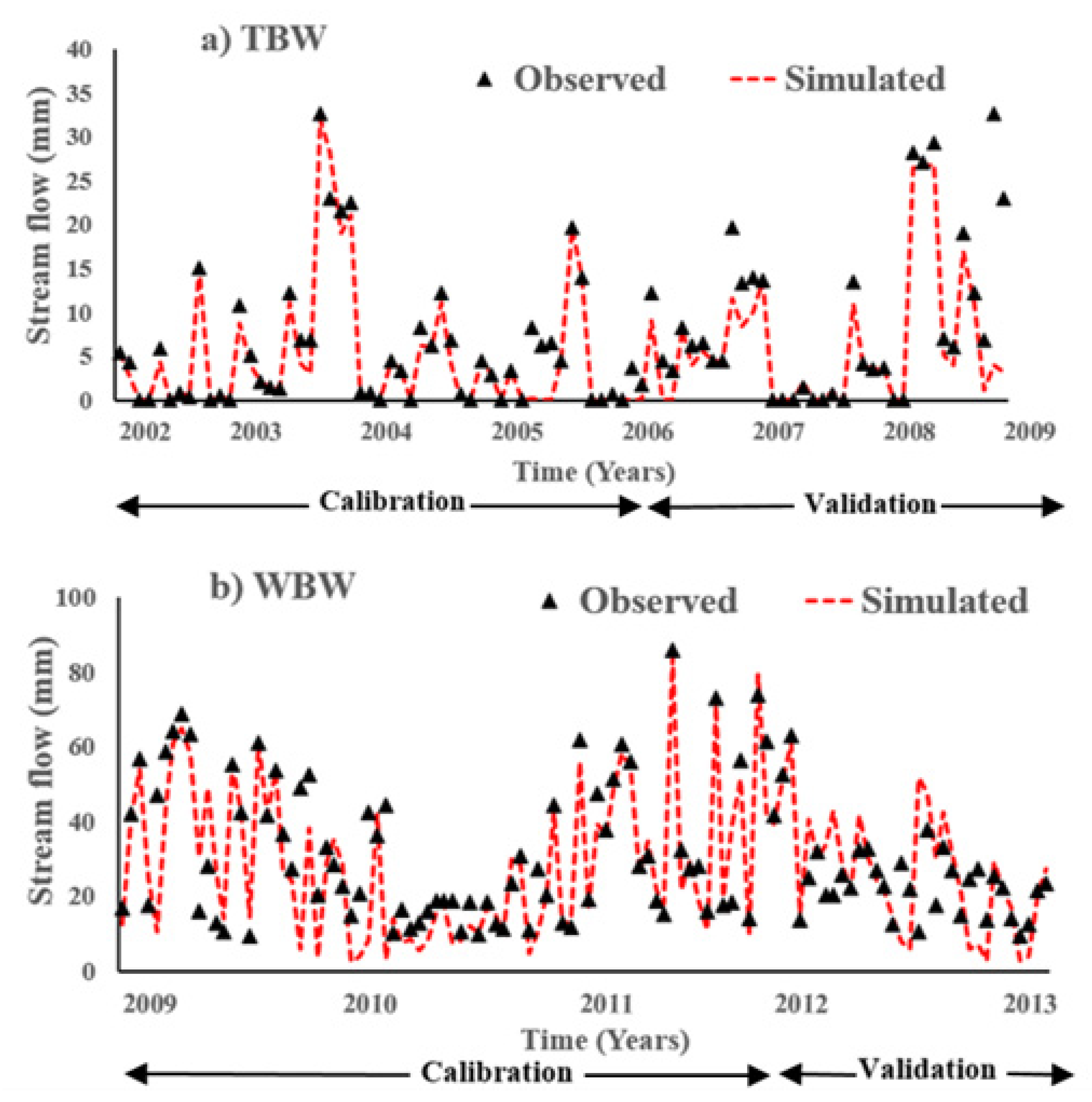
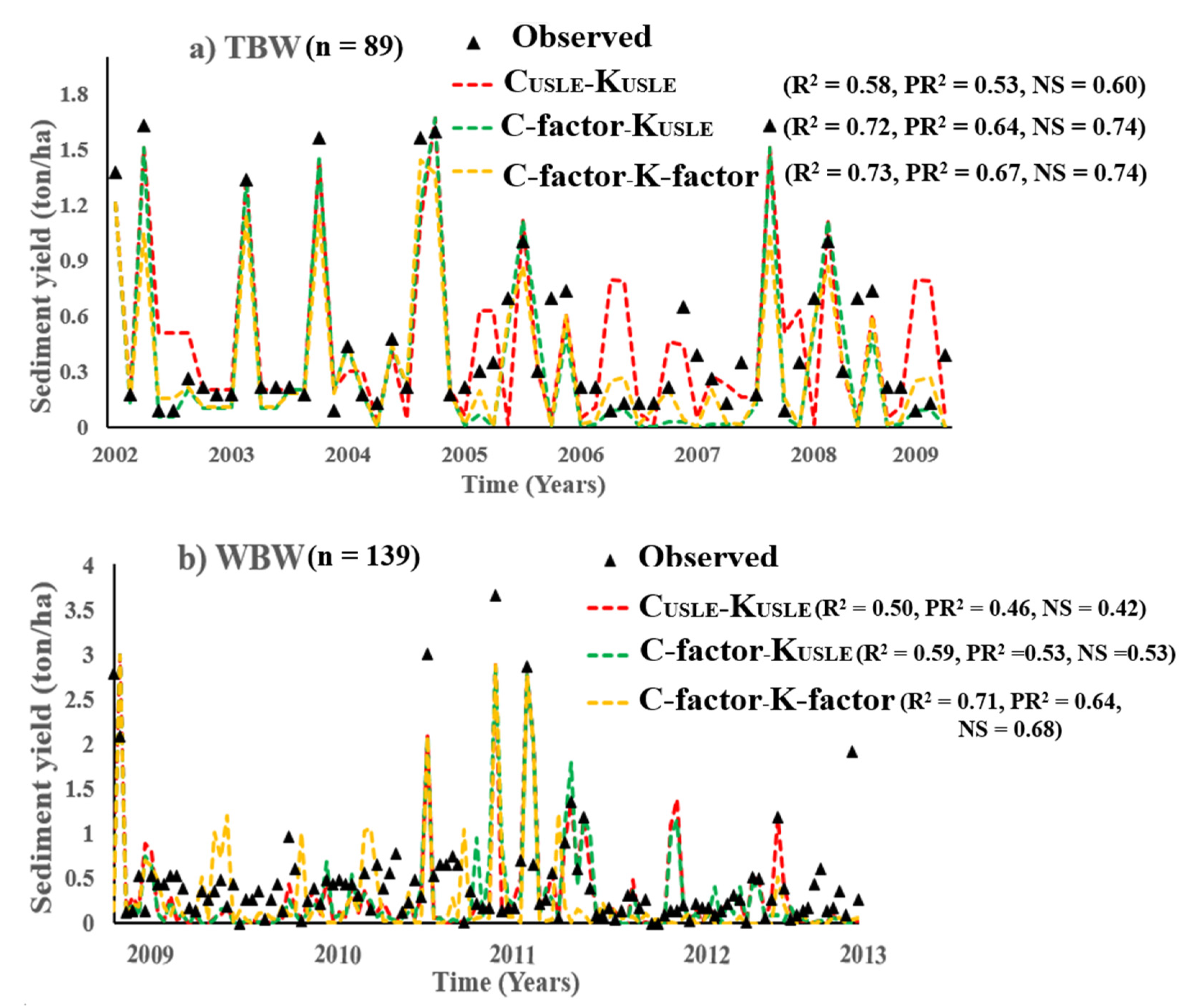
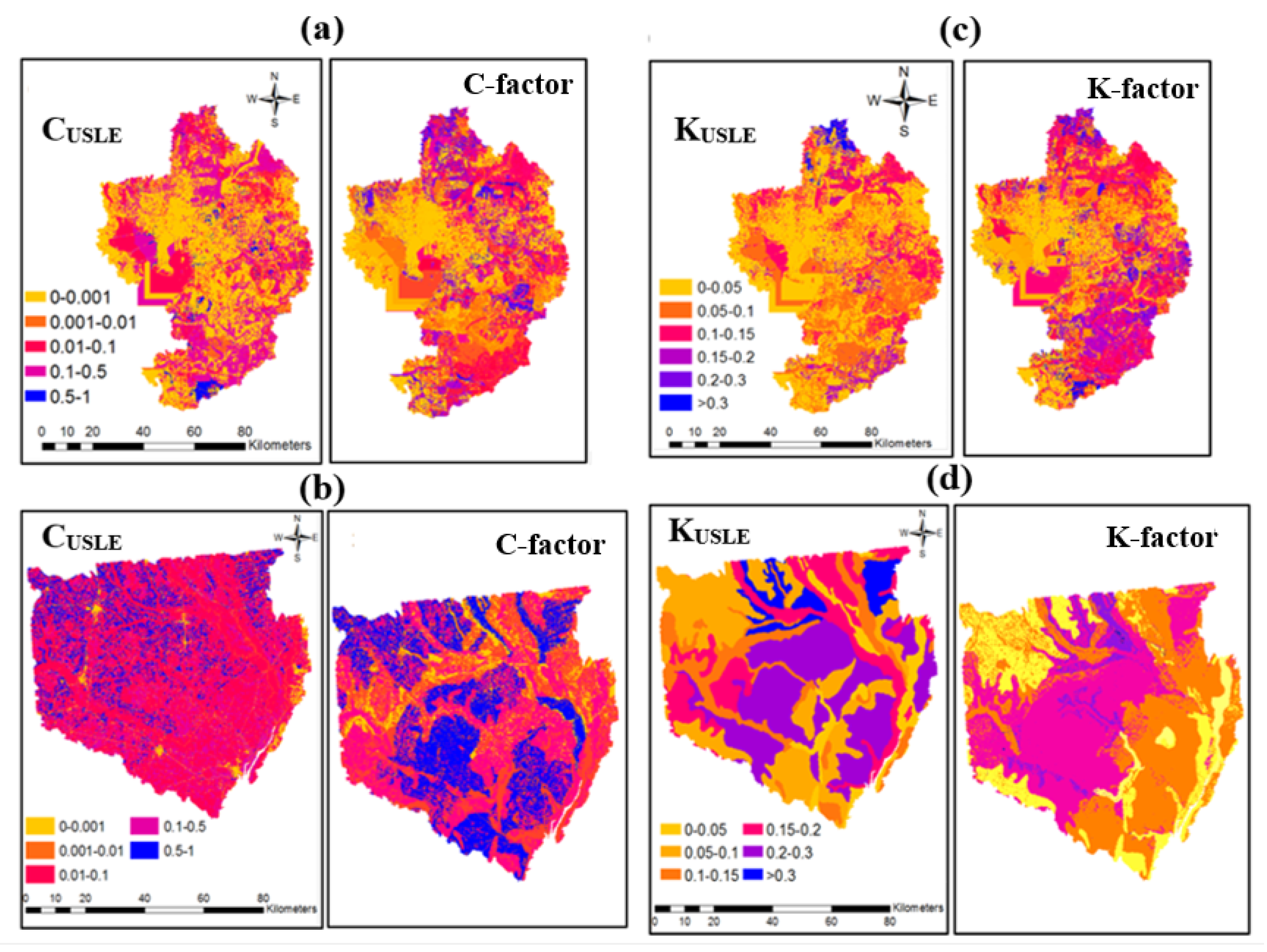
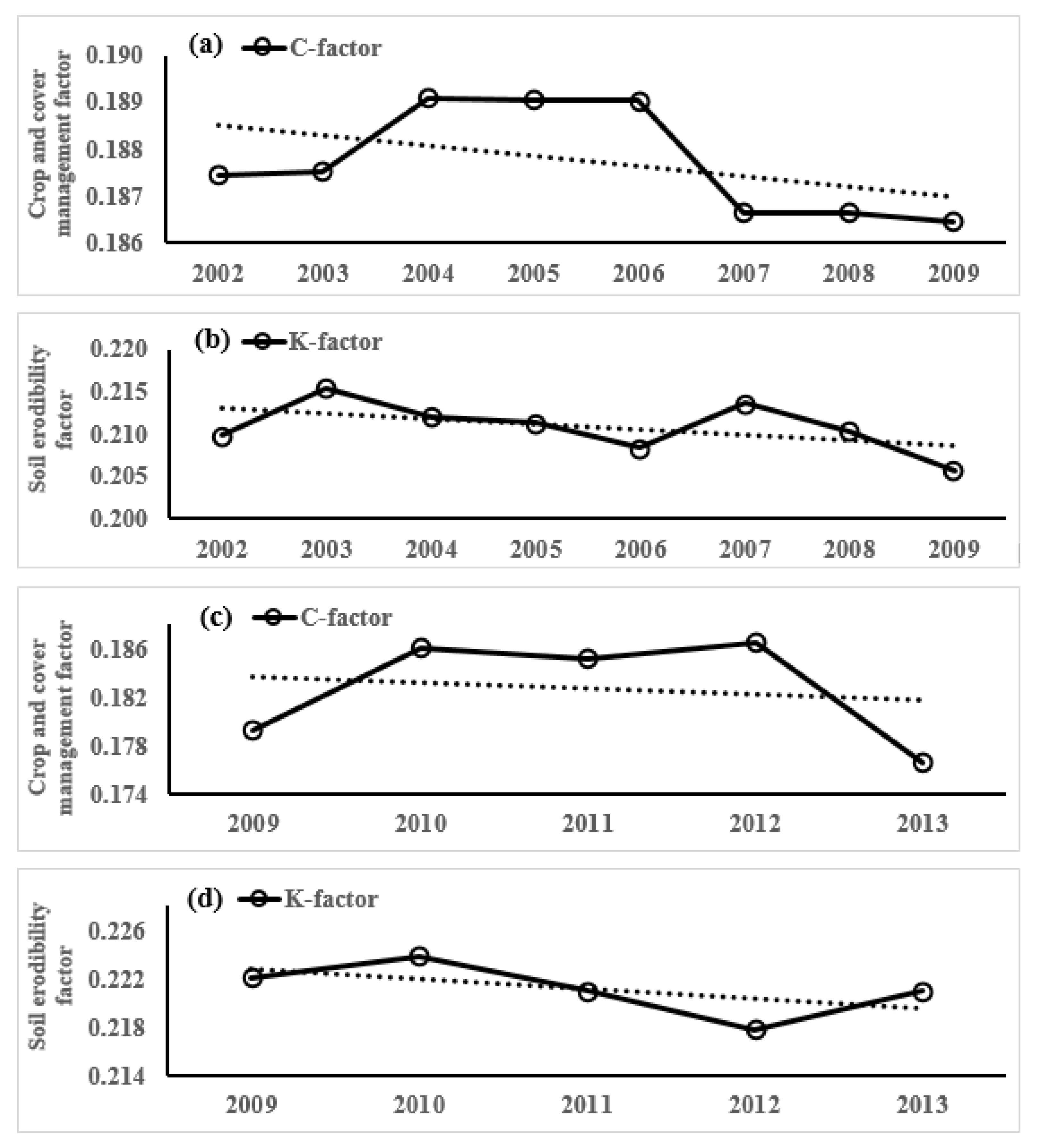

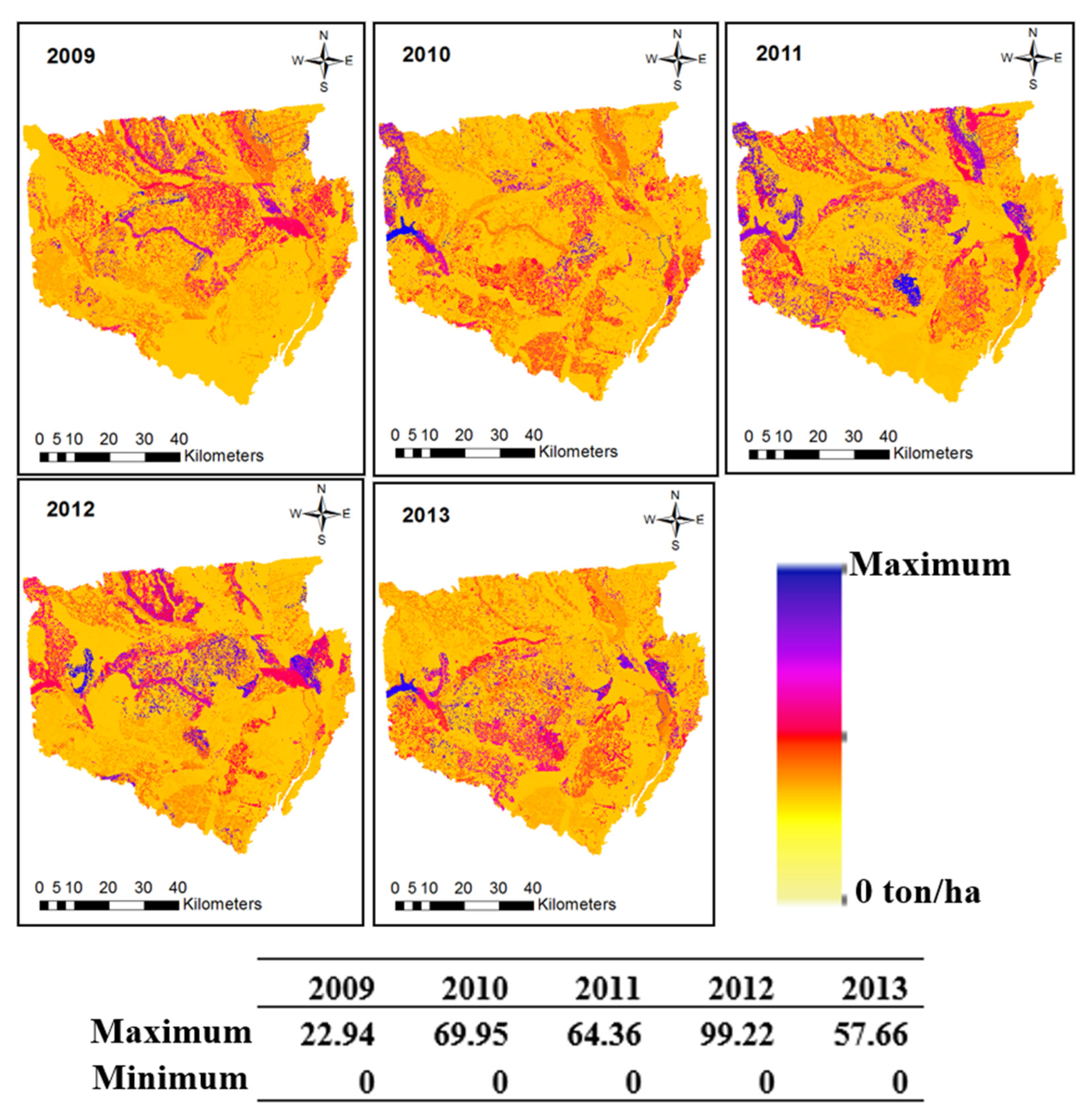
| Data | Data Sources | Information | Period |
|---|---|---|---|
| DEM (S, LS) | NED | Raster, Annual, 30 m | 2002–2013 |
| Land cover | USGS: MODIS: LP DAAC | Raster, Annual, 500 m | 2002–2013 |
| Soil (BD, Psoil) | USDA | Raster, Annual, 60 m | 2002–2013 |
| EVI AWC LAI SR Meteorological data Hydrological data | USGS: MODIS: LP DAAC USGS: MODIS: LP DAAC USGS: MODIS: LP DAAC USGS: MODIS: LP DAAC U.S. National Weather Service, NOAA USGS | Raster, 16-Day, 250 m Raster, Monthly, 250 m Raster, 8-Day, 500 m Raster, 8-Day, 500 m Daily, 250 m Daily, 250 m Monthly | 2002–2013 2002–2013 2002–2013 2002–2013 2002–2013 2002–2013 |
| Descriptive Statistics | AWC (%) | BD (g/cm3) | Psoil (mm/h) | LS (m) | A (sq·km) |
|---|---|---|---|---|---|
| Mean | 13.82 | 1.20 | 497.02 | 23.88 | 258.32 |
| Median | 12.27 | 1.25 | 537.50 | 19.75 | 36.34 |
| Mode | 24.60 | 0.87 | 487.50 | 0.00 | 0.18 |
| Minimum | 0.00 | 0.29 | 0.12 | 0.00 | 0.09 |
| Maximum | 37.49 | 1.78 | 875.00 | 403.48 | 13,356.90 |
| Descriptive Statistics | AWC (%) | BD (g/cm3) | Psoil (mm/h) | LS (m) | A (sq·km) |
|---|---|---|---|---|---|
| Mean | 23.33 | 1.17 | 121.90 | 22.94 | 276.95 |
| Median | 22.84 | 1.14 | 116.75 | 7.03 | 35.73 |
| Mode | 18.25 | 1.44 | 39.25 | 0.30 | 0.09 |
| Minimum | 17.47 | 0.20 | 2.80 | 0.00 | 0.01 |
| Maximum | 32.80 | 1.55 | 887.50 | 1131.53 | 10,426.52 |
| Parameters | Descriptions | TBW | WBW | ||
|---|---|---|---|---|---|
| Ranges | Fitted Values | Ranges | Fitted Values | ||
| Stream flow | |||||
| ESCO | Soil evaporation compensation factor | 0.85–1.00 | 0.824 | 0.80–1.00 | 0.83 |
| CN2 | SCS curve number | 1.00–2.00 | 1.73 | 1.00–2.00 | 1.55 |
| AWCS | Available water capacity of the soil layer | 0.00–1.00 | 0.324 | 0.00–1.00 | 0.44 |
| Sediment yield | |||||
| ERORGN | Organic N enrichment ratio for loading with sediment | 0.00–5.00 | 0 | 0.00–4.00 | 0.5 |
| ERORGP | Phosphorus enrichment ratio for loading with sediment | 0.00–5.00 | 0 | 0.00–4.00 | 0.2 |
| HRU_SLP | Average slope steepness | 0.00–1.00 | 0.215 | 0.00–1.00 | 0.43 |
| Observed Data | Test | Simulation Period | Monitoring Station | Performance | |
|---|---|---|---|---|---|
| R2 | NS | ||||
| Stream Flow | Calibration | 2002–2005 | Rocky Creek | 0.842 | 0.711 |
| Validation | 2006–2009 | 0.786 | 0.680 | ||
| Calibration | 2009–2011 | Black River | 0.767 | 0.632 | |
| Validation | 2012–2013 | 0.598 | 0.620 | ||
| Calibration | 2009–2011 | Lynches River | 0.566 | 0.543 | |
| Validation | 2012–2013 | 0.587 | 0.518 | ||
| Calibration | 2009–2011 | Pee Dee River | 0.762 | 0.688 | |
| Validation | 2012–2013 | 0.655 | 0.645 | ||
| Sediment Yield | Calibration | 2002–2005 | Rocky Creek | 0.560 | 0.533 |
| Validation | 2006–2009 | 0.601 | 0.589 | ||
| Calibration | 2009–2011 | Black River | 0.662 | 0.644 | |
| Validation | 2012–2013 | 0.572 | 0.512 | ||
| Calibration | 2009–2011 | Lynches River | 0.442 | 0.360 | |
| Validation | 2012–2013 | 0.468 | 0.376 | ||
| Calibration | 2009–2011 | Pee Dee River | 0.691 | 0.564 | |
| Validation | 2012–2013 | 0.644 | 0.590 | ||
| Performance Indices | TBW | WBW | ||||
|---|---|---|---|---|---|---|
| Case 1 | Case 2 | Case 3 | Case 1 | Case 2 | Case 3 | |
| NS | 0.603 | 0.741 | 0.744 | 0.418 | 0.527 | 0.683 |
| R2 | 0.582 | 0.719 | 0.733 | 0.503 | 0.594 | 0.713 |
| PR2 | 0.531 | 0.636 | 0.668 | 0.462 | 0.533 | 0.644 |
Publisher’s Note: MDPI stays neutral with regard to jurisdictional claims in published maps and institutional affiliations. |
© 2022 by the authors. Licensee MDPI, Basel, Switzerland. This article is an open access article distributed under the terms and conditions of the Creative Commons Attribution (CC BY) license (https://creativecommons.org/licenses/by/4.0/).
Share and Cite
Preetha, P.; Al-Hamdan, A. A Union of Dynamic Hydrological Modeling and Satellite Remotely-Sensed Data for Spatiotemporal Assessment of Sediment Yields. Remote Sens. 2022, 14, 400. https://doi.org/10.3390/rs14020400
Preetha P, Al-Hamdan A. A Union of Dynamic Hydrological Modeling and Satellite Remotely-Sensed Data for Spatiotemporal Assessment of Sediment Yields. Remote Sensing. 2022; 14(2):400. https://doi.org/10.3390/rs14020400
Chicago/Turabian StylePreetha, Pooja, and Ashraf Al-Hamdan. 2022. "A Union of Dynamic Hydrological Modeling and Satellite Remotely-Sensed Data for Spatiotemporal Assessment of Sediment Yields" Remote Sensing 14, no. 2: 400. https://doi.org/10.3390/rs14020400






